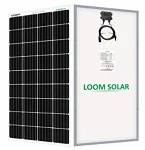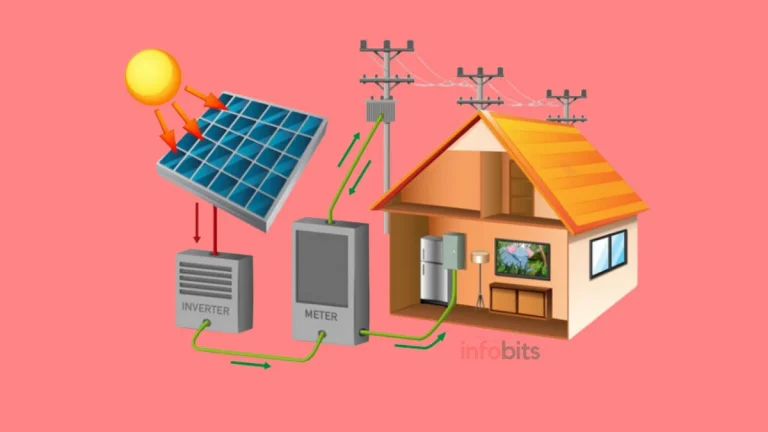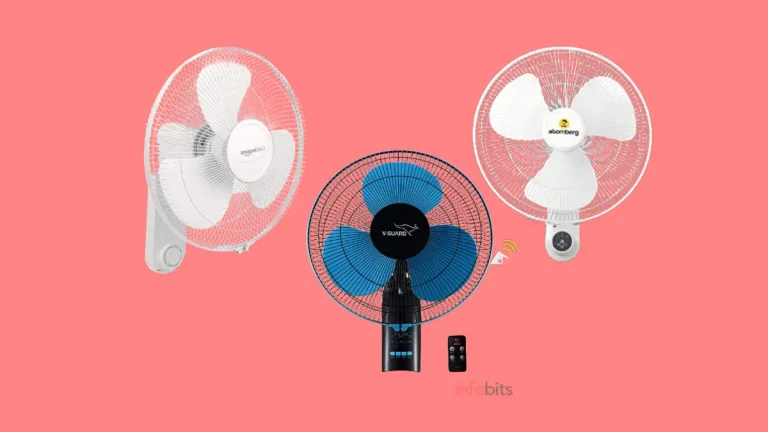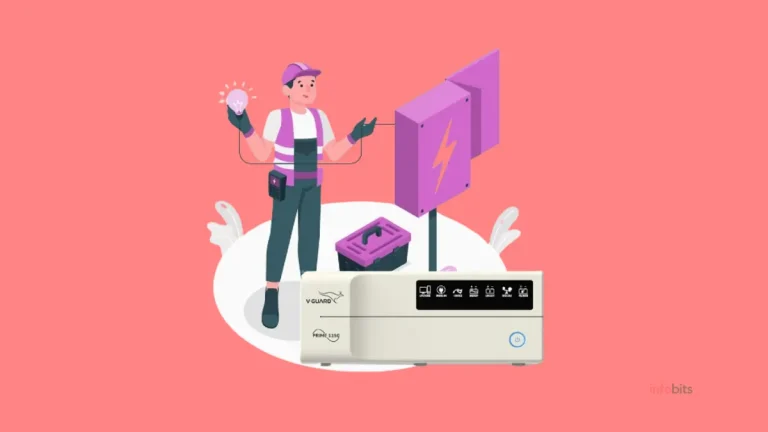How to Select Solar Panels for Home or Office in India?
When deciding on a solar power system, the selection of a solar panel is critical. It is worthwhile to read our selection guide for the inverter and its battery in this context.
Before digging deeper into the factors to consider when selecting solar panels, let us first understand some fundamental concepts about them.
What is a Solar Panel?
Solar panels, also known as PV (Photovoltaic) panels, are a collection of solar cells that convert light energy (photons) into electrical energy.
These photos are considered to be energy particles. The photovoltaic effect refers to the conversion of light energy into electrical energy.
Each solar cell can produce far less voltage and current than is required for practical use. As a result, solar cells are arranged in a specific way to achieve cumulative power that meets our needs.
A solar panel or a solar module is a systematic arrangement of solar cells in a rigid metal frame covered by a thin layer of a glass sheet.
How Do Solar Panels Function?
We’ve just seen what a solar panel is and the principle behind energy conversion.
As previously stated, the solar cell is the fundamental component of a solar panel. These solar cells are constructed of photovoltaic silicon.
This means it can absorb photons from the sun and emit electrons, resulting in a potential voltage in the solar cell.
We achieve the required voltage and power by interconnecting all solar cells to form a solar panel module.
Solar panels, in short, absorb pure renewable energy in the form of sunlight and convert it into electrical power that can be fed to external loads or batteries.
Related: How Do You Convert A Normal Inverter To A Solar Inverter?
Different Types of Solar Panels Available in India
Solar panels are classified as follows based on their construction details. When looking for the best solar panels, we should understand this classification.
All of these panels perform the same function, which is to convert sunlight into electricity, and their primary raw material is silicon.
The following are the main types of solar panels available in India.
1. Monocrystalline:
These solar panels are constructed from a single crystal of pure silicon. Each solar cell is made up of a single, continuous piece of silicon crystal bars in this case.
Since the purest single-crystal silicon wafers are used to create monocrystalline panels the efficiency of these types of solar panels will be higher.
Because single-crystal silicon production is complicated and costly, monocrystalline panels may be more expensive. These panels are easily recognized by their excellent black tone.
Because the solar cell is made of a single crystal, electrons have more room to move. As a result, they are considered to be more energy-efficient and smaller in size for unit power.
In terms of comparison price, monocrystalline solar panels are more expensive than polycrystalline panels.
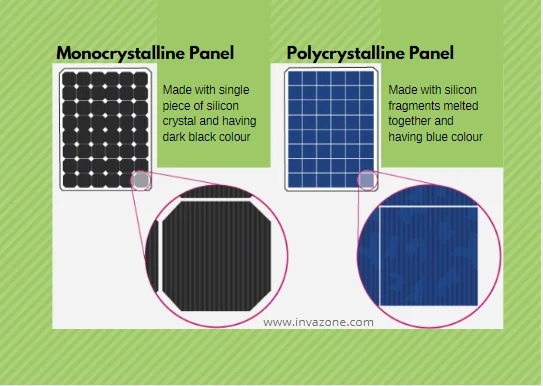
2. Polycrystalline:
Polycrystalline (also known as multi-crystalline) solar panels are also made of silicon.
However, unlike monocrystalline silicon, each cell is made up of multiple silicon fragments melted together to form a silicon wafer.
Polycrystalline panels are composed of non-pure silicon and lack a fixed crystal structure. When compared to monocrystalline panels, they are less expensive to manufacture. Simultaneously, efficiency is relatively poor.
Because each cell contains many crystals, electrons do not have as much space to move around as they do in monocrystalline technology.
As a result, polycrystalline panels are less energy-efficient than their monocrystalline counterpart. In the case of polycrystalline, the colour shade is a little blue rather than black as in Monocrystalline.
3. Thin-Film (Amorphous):
These are the most recent additions to the category.
Thin-film solar panels are made of solar cells with a thin layer of photovoltaic material that is approximately 350 times thinner than standard solar panels.
Amorphous silicon (a-Si), Cadmium Telluride (CdTe), Copper Indium Gallium Selenide (CIGS), or Gallium Arsenide are the most common materials used in thin-film solar panels ( GaAs).
They use a much lower level of photovoltaic material than other technologies, as the name implies.
Thin-film panels are less expensive and smaller in size than standard solar panels. However, energy efficiency is slightly lower, hovering around 11-13 per cent, compared to 15-20 for crystalline panels.
However, its low efficiency can be counterbalanced to some extent by its lightweight, which results in lower installation costs.
Crystalline panels are more common than Thin Film panels. Because Amorphous or Thin-film solar panels are not suited for common household use, we will exclude them from our discussion and concentrate on poly and monocrystalline panels.
4. Mono PERC Panels
Mono PERC panels are a variant of monocrystalline panels
PERC, which stands for Passivated Emitter and Rear Cell or Passivated Emitter and Rear Contact, is the most recent advancement in solar panel technology.
Standard solar crystals are coated with an extra reflective coating on the backside in this technology. This passive layer reflects solar light to the solar crystals, reducing solar energy waste.
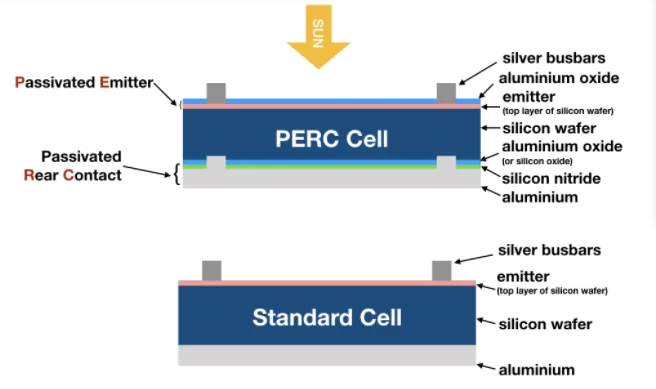
This extra layer reflects solar light to the solar cells that were missed in the first attempt. This would improve the solar panel’s overall performance.
This additional coating reflects even more of the heat energy that falls on the backside metal sheet of the solar panels. As a result, the heat generated by the solar panels would be reduced.
Low-temperature PERC panels are also more efficient than standard solar panels.
Because PERC technology is commonly used in Mono Crystalline Solar Panels, they are also known as Mono PERC Solar Panels.
This Passive Layer can be used not only behind monocrystalline panels but also behind polycrystalline panels if desired. However, in general, only mono PERC panels are available on the market.
PERC technology is a low-cost construction technology that can be combined with monocrystalline panels. Even though there is no significant difference in construction costs, these Mono PERC panels are marketed as new technology and sold at a higher price.
However, in the current scenario, most manufacturers are trying to narrow the gap by lowering the price of Mono PERC panels.
5. Mono PERC Half Cut Solar Panels
These are Mono PERC panels themselves.
A solar panel, as we all know, is made up of a series of tiny solar cells that are connected in series and parallel. In this layout, half-cut panels are made with a slight change.
Assume 50 cells are used in a square foot size solar panel; these 50 cells in half cut panels are cut in half and made into 100 cells, which are then arranged in series-parallel combinations.
What is the benefit of this?
There is no significant difference in output or efficiency. However, as the current flowing through each cell decreases, the energy loss in the form of thermal energy can be reduced.
Similarly, when cells in a normal panel are connected one after the other, even the smallest shadow cast by a tree or other element on one cell reduces the total energy produced by the solar panels.
Even though there are unaffected panels in the series connection, power generation is significantly disrupted as a result of this series connection.
However, because half-cut panels have more parallel cells, the panel’s energy reduction problem is completely or partially solved, and even the slightest shadow casting greatly disrupts solar energy conversion.
The additional cost of cutting and attaching cells makes these panels more expensive than conventional panels.
Things to Consider When Choosing the Best Solar Panels in India
Many people are confused about how to select good solar panels for their homes. The following are critical factors to consider when choosing a solar panel for your home.
1. Power Rating
When choosing the best solar panels, the power rating of the solar panel is the first and most important factor to consider.
Typically, it is determined by your solar system power requirements. The power output of the solar panel is indicated in the solar panel specifications.
The industry-standard panel output rating of up to 440W is available. The maximum power output indicated on the nameplate is the maximum power output that the solar panel can produce under normal conditions.
However, in practice, this ideal lab conditions power is difficult to achieve. When selecting a solar panel for home or industrial use, some allowance must be made in the power calculation.
When choosing a solar panel for an inverter power system, the inverter manufacturer specifies the maximum wattage of the solar panel that can be connected.
2. Power Tolerance
The power tolerance is the range over which the power generated by the solar panel can vary.
When choosing a solar panel, this must be taken into account. It is also a specification parameter for solar panels. It is denoted by a +/- percentage.
Assume that the power tolerance of a 300 W solar panel is +/-5 per cent. It implies that the solar panel’s power ranges from 285W (-5 per cent of 300W) to 315W (+5 per cent of 300W).
Use a solar panel with a lower power tolerance because its output may not vary over a wide range.
3. Efficiency of a Solar Panel
The ability of a solar panel to convert sunlight into electrical energy is what determines its efficiency.
The amount of sunlight falling per square meter of an area that can be converted into electrical energy is referred to as the efficiency of solar panels.
This factor is critical to the overall efficiency of the solar system. The solar panel’s efficiency is defined as the ratio of output power (electrical) to input power (sunlight).
Solar panel efficiency is typically expressed as a percentage.
Under ideal conditions, today’s commercially available solar panels have an energy efficiency of up to 23%. The efficiency of solar panels available in India varies from 15% to 23%.
The highest chance in this proportion, depending on the different technologies, is about two or three per cent. This means that the great majority of available sunlight is being wasted.
In this area, research is being conducted to create a method that will avoid this wastage and convert as much sunlight as possible into power.
More watts of electrical energy will be generated per unit square area of the panel if the efficiency is higher. The cost of a solar panel rises in direct proportion to its efficiency rating.
If cost is not an issue, it is preferable to go with high-efficiency monocrystalline solar panels, which would be a wise choice in the selection of the best solar panels.
4. Temperature Coefficient
The temperature coefficient represents the effect of temperature on solar panel efficiency.
As previously stated, the basic raw material of the solar panel is silicon, which has a negative temperature resistance coefficient. As a result, with an increase in temperature, there is more electron flow in the panel, which can lead to a drop in voltage/power.
The panel’s efficiency decreases when the ambient temperature exceeds 25 ° C, the standard temperature at which the tests are conducted.
Solar panels with a lower temperature coefficient provide better performance over a longer life cycle, so keep this in mind when choosing a solar panel.
5. Quality & Durability
Always choose a solar panel from a reputable manufacturer with extensive experience in this field or one that adheres to the relevant international standards (IEC 61215) to ensure a high-quality product.
Durability, like quality, is a measure of how long the panel can withstand harsh real-world conditions.
The panels should be able to withstand strong winds, heavy rains, and other adverse weather conditions.
A panel from a certified manufacturer has always been subjected to various endurance tests before it is commercially available, so we can expect high-quality and long-lasting solar panels from them.
6. Service and Warranty
Aside from the previously mentioned factors, the manufacturer’s service and warranty are also important considerations.
Always choose a manufacturer with a proven track record of providing excellent support and warranties.
Typically, solar panel manufacturers provide two types of warranties. One is a material warranty, and the other is a warranty on power production.
a) Material Warranty
The materials warranty protects you against failure due to manufacturing flaws, durability, and environmental issues.
Almost all solar panel manufacturers guarantee that their panels will be trouble-free for at least 10 to 12 years. They will provide continuous assistance during this time.
b) Power Production Warranty
A good manufacturer will also provide you with a standard power generation warranty for up to 25 years.
The energy efficiency of solar panels, which may be high in the first year, degrades naturally over time.
Standard manufacturers ensure that their panel retains a certain percentage of power efficiency that is greater than or equal to 80 per cent.
A higher percentage of matrices is better than a lower one in this case, and it is a good indicator of the best solar panels.
These are just a few of the most important factors to consider when choosing the best solar panels for your needs.
Related: AC Solar Panels; Things You Should Know
Frequently Asked Questions
Some of the best solar panel brands available in the Indian market are Loom Solar, Luminous, Microtek, Tata, and Exide. All of these companies offer the best solar panels for home use in India.
The only noticeable difference is that a kilowatt of polycrystalline panels takes up more space than a kilowatt of monocrystalline panels.
Similarly, monocrystalline panels are available as single panels at higher wattages, i.e. poly panels in the 330-350 watt range and mono panels in the 400-450 watt range.
As a result of using monocrystalline panels, more capacity plants can be built in areas where space is limited. There is no point in spending a lot of money on mono panels if you have enough rooftop space.
Don’t fall for marketing gimmicks like “more output even in low light,” “higher efficiency,” and “long life.”
You may figure out how many solar panels you need by calculating your household’s hourly energy use by the peak sunshine hours in your location and dividing the result by the wattage of a panel.
Polycrystalline, monocrystalline, and thin-film solar panel cells are the three main types. Mono PERC and Mono PERC half-cut panels, which are variants of monocrystalline solar panels, are now available.
ACS can easily be powered by on-grid solar systems with capacities ranging from 3 kW to 10 kW. An on-grid solar system can power the air conditioners in big commercial office buildings.
We hope you find this information useful, and please share it with your friends and relatives.
Subscribe to our free newsletter so that you will get similar articles and regular updates directly in your Email.
Also, consider following our Facebook and Twitter pages for regular updates.
Disclosure: If you follow our links to a retailer’s website and make a purchase, we will get an affiliate commission on some, but not all, of the items or services we promote. This will cause no price change for you.


